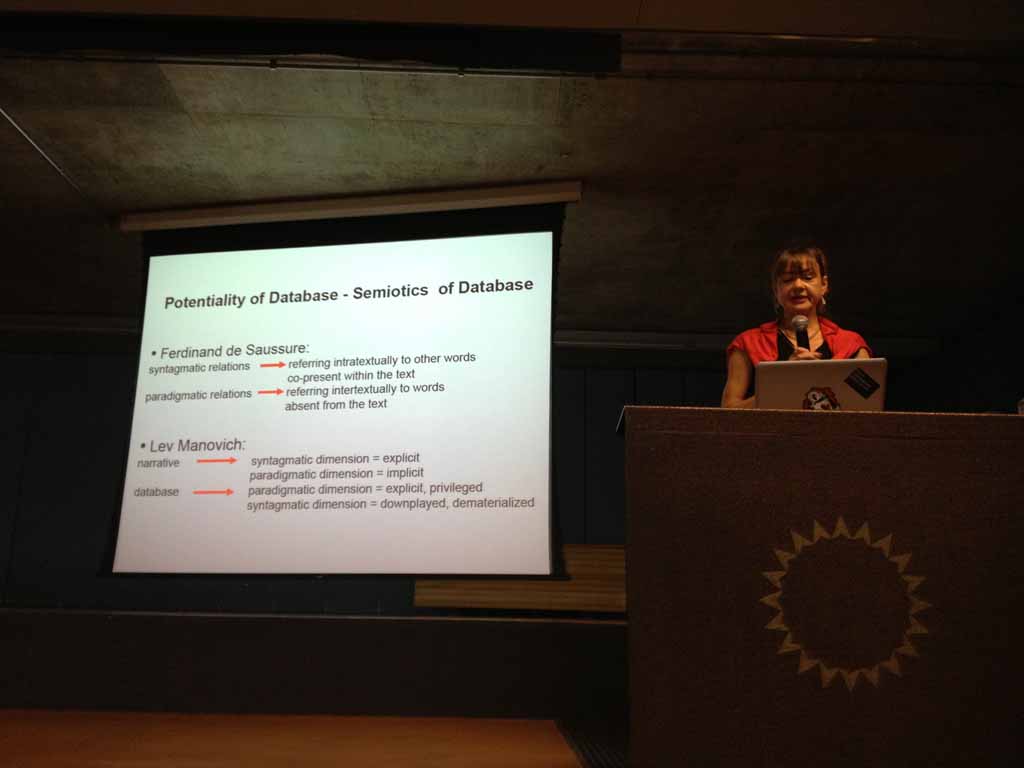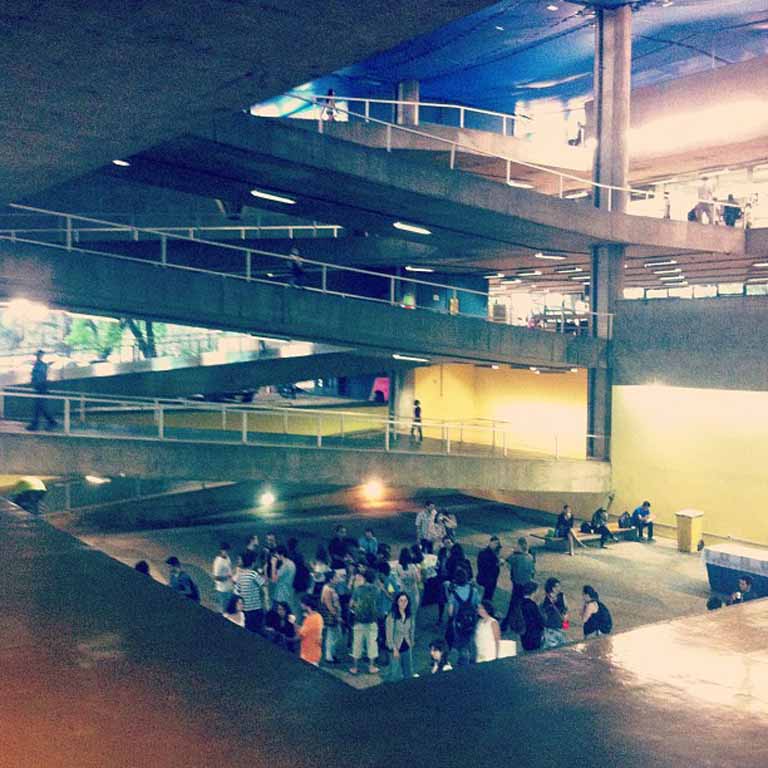Possible Futures took place in October 2012 in Sao Paulo. Gerfried Stocker and Manuela Naveau helped develop this conference, curator Giselle Beiguelman reveals how the collaboration came along and what we should take away from the conference.
What was the motivation to organize the conference?
The motivation was the challenge of thinking about the status of memory itself today, in the context of the digitalization of culture in all its levels. Few words have become as commonplace as “memory”. Memory, which until recently has been limited to historiographical, neurological and psychoanalytical fields of study, has now become a primary aspect of the everyday life. After all, memory is a sort of quantifiable datum nowadays, a measurement and even an indicator of one’s social status. A fetish has been made of “memory” as a “thing”: _ How much memory does your computer have? _What about your camera? _And your mobile? _All that?! _ Only that?… Memories are bought, memories are transferred, and memories are erased and lost. Paradoxically, the over-use in discourse is equivalent to a methodological emptiness when it comes to cultural products created with the different media related to these memories: digital media.
How did you choose the topic and why?
In the context I described above, some questions become central: How to preserve the memory of cultural devices that resist objectification, which often exist only contextually – such as net art – and whose processing includes its erasure? How to deal with such unstable memories, which last the same as the service life of the equipment and whose typology does not correspond to current models of cataloguing museum and archives collections? How is it possible, nowadays, not to think of cultural memory as both an economic issue and a service that should call for some sort of ethical code? After all, personal memories are increasingly mediated by corporations – which appear as big data repositories – through services that are interrupted as soon as they are no longer considered an interesting niche market. In order to avoid giving in to a catastrophist hypothesis, the option was to propose a reflection upon the new meanings of memory and memorization technologies.
Working with Ana Magalhães (from the Museum of Contemporary Art at the University of São Paulo) , Manuela Naveau and Gerfried Stocker, we decided to to discuss strategies and methodologies for the storage and preservation of digital art, as well as processes of digitalization of collections, also including studies on ways of organization and access of information. In addition to this, we considered important to bring people to show some case studies and programs, and analyses of the rise of the database aesthetics and the emerging field of information curation.
Based on this, the symposium was organized into four thematic sessions: New Memories: Archives of the Future; Between Past and Future: The Construction of the Present; The Web-Collector: Alternative and Underground Archives and Museums; Information Curation and the Database Aesthetics.
The first theme was devoted to new approaches in museology, archiving and storage, which are dealing with the preservation and collecting procedures of digital culture. The second presented analyses and experiences of digitization of different kinds of non-digital collections. The third theme approached personal, informal and underground new forms of archiving. The last one aimed at reflecting on the emerging issues related to archiving processes and practices.
In your opinion, what are the things we all could take away from the conference and apply them in everyday life?
Gerfried Stocker
From an institutional point of view it was an amazing experience of organizing such an important event with partners that worked remotely for one year, dealing with different sources of support and with a large amount of public resources.
From a more conceptual point of view, some themes and discussions showed that so important as to discuss new approaches and methodologies for preserving digital art and culture is to pay attention to an emergent documentation industry, which makes the record more important than the action itself.
The debates also stressed, in different ways, how non-institutional initiatives are breaking the paradigms of the traditional archives and museums and how important it is to consider the politics of the database culture and its corporate mediation.
What was the atmosphere like during the conference, do you have some photos showing a little of the place this all happened in?
Relaxed, friendly and confortable. Very Brazilian, I would say… At the same time, very international, with people from so many countries and cultural traditions sharing the same space.
We reserved some time in our program for cultural tours and this also gave to our guests the opportunity to see something beyond the university. We visited the Pinacoteca – the oldest museum of São Paulo, which has an amazing collection of Brazilian art from the 19 century and it is located in a building in the oldest part of town –, the São Paulo Biennial, located in the modernist park of Ibirapuera, and the new Museum of Contemporary Art Building (under construction).
I learned a lot being a jury member at the ars electronica and the way the AEC combines work and social activities and with Ana Magalhães ability in formulating relaxing and productive cultural activities.
The green atmosphere of the University of Sao Paulo, with its Tropical gardens, and the unique architecture of the building of the Faculty of Architecture and Urbanism – with rooms without doors and balconies without protection walls –, were an important element for the amazing pleasant days we shared in October there.
What are the plans for the future, what are your personal plans, how do you take care of your cultural heritage?
We published a full video documentation of the Symposium, in Portuguese and English and we frequently update our blog, our Facebook page () and our Pinterest board. Moreover, there is an incredible interesting documentation archived in the Ars Wild Card web site.
Now, we are totally committed to the production of the Symposium book, a bilingual edition to be published in October 2013. This book will also include a chapter written by Oliver Grau, whom we missed a lot in the conference.
I’m now in charge — as Coordinator — of the Media Center of the School of Architecture and Urbanism at the University of Sao Paulo (INTERMEIOSFAU – , a huge archive of video and photography which is now expanding its collection with digital products and design). Also, I’m organizing with some students a Research Group on Digital Art and Technologies for Cultural Preservation.
My personal heritage… I think my own experience, as a digital artist from the Jurassic Park of the Internet could be a case study… Some of my “classics” like The Book After the Book (1999) and Sometimes Always/Sometimes Never (from 2007, and part of the ZKM collection) are “victims” of the process of programmed obsolescence. This last piece, for instance, was fully rebuild for the YOUser exhibition at the ZKM, months after it was incorporated to the museum collection. I really don’t think everything is lost, but I’m sure we need to think seriously of new ways of memorizing and preserving the past, without the presence of the interfaces we built formerly. Those interfaces, especially when we talk about net practices, are related to connection devices (transmission speed, routes, backbones, screen resolutions, Internet Providers etc), which simply cannot be restored and preserved. Net art is contextual art, as Christiane Paul states, and I agree. Nevertheless, all our technologies and politics of memorization (museums, archives etc) were formulated in the 19 century, based on the relation of the support and the thing/ object itself. Digital culture is different. It demands more and more politics of the interface. New strategies of emulation processes could be an interesting point of departure to think about this. Paraphrasing Domenico Quaranta, I would say the emulated copy would save us. Otherwise, we will be condemned to our immediate present and this would be really boring and narcissist.
—-
Possible Futures (International Symposium)
Chairs
Giselle Beiguelman (FAUUSP)
Ana Gonçalves Magalhães (MAC-USP)
Co-chair
Gerfried Stocker (Ars Electronica)
Organization
Giselle Beiguelman (FAUUSP)
Ana Magalhães (MAC-USP)
Manuela Naveau (Ars Electronica)
Realization
FAUUSP
Co-realization
Ars Electronica
Sponsor
Fapesp
Support
CPC-USP
Capes
Austrian Embassy in Brazil
Participants
- ANA PATO (Videobrasil, BR)
- ANDRÉ STOLARSKI (Bienal de São Paulo, BR)
- ANNET DEKKER (Goldsmiths University, UK/ NL)
- ARIANNE VANRELL (Museo Reina Sofia, ES)
- BETH SAAD (ECA – USP, BR)
- CHRISTIANE PAUL (Whitney Museum, US)
- CICERO SILVA (Software Studies Brazil, BR)
- DANIELA KUTSCHAT HANNS (FAU-USP)
- DOMENICO QUARANTA (Accademia di Bella Arti di Brera, IT)
- GABRIELA PREVIDELLO (FILE Archive, BR)
- GERFRIED STOCKER (Ars Electronica, AT)
- GILBERTTO PRADO (ECA – USP, BR)
- GUILHERME KUJAWSKI (Itaú Cultural, BR)
- GUSTAVO ROMANO (Netescóspio, MEIAC, ES)
- JOSÉ LUIS DE VICENTE (MediaLab Prado, ES)
- LUCAS BAMBOZZI (ARTE.MOV, BR)
- MANUELA NAVEAU (Ars Electrocnica, AT)
- MONIKA FLEISCHMANN & WOLFGANG STRAUSS (netzspannung.org, DE)
- PAULA ALZUGARAY (PUC-SP, BR)
- PATRICIA KUNST CANETTI (Canal Contemporâneo, BR)
- PEDRO PUNTONI (Brasiliana USP, BR)
- RENATA MOTTA (Secretaria de Estado da Cultura de SP, BR)
- RUDOLF FRIELING (SFMoMA, US)


